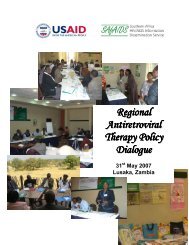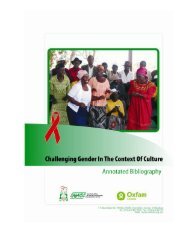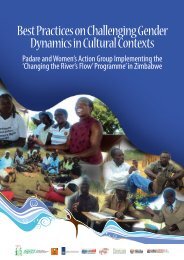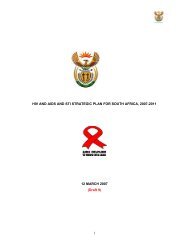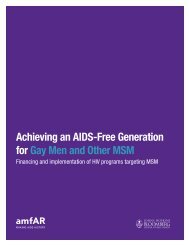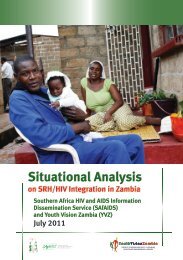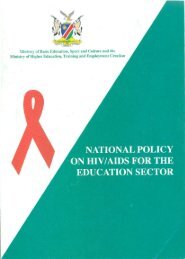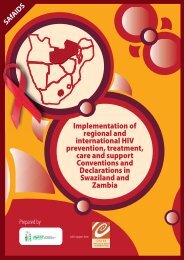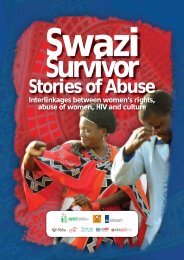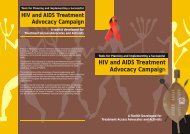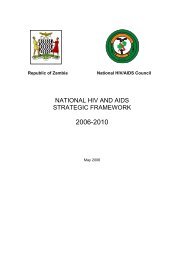Prevention for Positives: A Course Module for Healthcare ... - SAfAIDS
Prevention for Positives: A Course Module for Healthcare ... - SAfAIDS
Prevention for Positives: A Course Module for Healthcare ... - SAfAIDS
Create successful ePaper yourself
Turn your PDF publications into a flip-book with our unique Google optimized e-Paper software.
<strong>Prevention</strong> <strong>for</strong> <strong>Positives</strong>: A <strong>Course</strong><strong>Module</strong> <strong>for</strong> <strong>Healthcare</strong> ProfessionalsFacilitator’s GuideGretchen Bachman, MIM | MBALeine Stuart, RN, PhD, ACRN
<strong>Prevention</strong> <strong>for</strong> <strong>Positives</strong>: A <strong>Course</strong><strong>Module</strong> <strong>for</strong> <strong>Healthcare</strong> ProfessionalsFacilitator’s GuideLeine Stuart, RN, PhD, ACRNGretchen Bachman, MIM | MBA
© 2007 Family Health International (FHI). All rights reserved. This book may be reviewed, quoted,reproduced, translated, or adapted in full or in part, provided the source is acknowledged. This documentwas funded by the US Agency <strong>for</strong> International Development (USAID) through FHI’s Implementing AIDS<strong>Prevention</strong> and Care (IMPACT) Project, Cooperative Agreement HRN-A-00-97-00017-00.
CONTENTSAcknowledgments. . . . . . . . . . . . . . . . . . . . . . . . . . . . . . . . . . vAcronyms . . . . . . . . . . . . . . . . . . . . . . . . . . . . . . . . . . . . . vIntroduction. . . . . . . . . . . . . . . . . . . . . . . . . . . . . . . . . . . . 1Slide 1. <strong>Prevention</strong> <strong>for</strong> <strong>Positives</strong> . . . . . . . . . . . . . . . . . . . . . . . . . . 2Slide 2. Purpose. . . . . . . . . . . . . . . . . . . . . . . . . . . . . . . . 2Slide 3. Objectives. . . . . . . . . . . . . . . . . . . . . . . . . . . . . . . 3Slide 4. What is prevention <strong>for</strong> positives? . . . . . . . . . . . . . . . . . . . . . . 3Slide 5. Why is prevention <strong>for</strong> positives crucial? . . . . . . . . . . . . . . . . . . . . 4Slide 6. Why providers play a critical role. . . . . . . . . . . . . . . . . . . . . . . 5Slide 7. Strategies <strong>for</strong> providers . . . . . . . . . . . . . . . . . . . . . . . . . . 5Slide 8. Self-test. . . . . . . . . . . . . . . . . . . . . . . . . . . . . . . . 6Slides 9–10 The facts on HIV re-infection (1–2). . . . . . . . . . . . . . . . . . . . 7Slides 11–12 The facts on HIV and STDs (1–2). . . . . . . . . . . . . . . . . . . . . 8Slides 13–15 The facts on HIV and contraception (1–3). . . . . . . . . . . . . . . . 9–10Slides 16–18 The facts on pregnancy and HIV (1–5). . . . . . . . . . . . . . . . . 10–12Slides 21–22 The facts on condoms and sexual dysfunction (1–2) . . . . . . . . . . . . . 13Slide 23. Self-test review. . . . . . . . . . . . . . . . . . . . . . . . . . . . 14Slide 24. How to talk to clients about prevention. . . . . . . . . . . . . . . . . . . 15Slide 25. Explain facts using lay terms. . . . . . . . . . . . . . . . . . . . . . . 15Slide 26. Ask open-ended questions. . . . . . . . . . . . . . . . . . . . . . . . 16Slide 27. Give clients reasons that matter to them . . . . . . . . . . . . . . . . . . . 16Slide 28. Put clients at ease. . . . . . . . . . . . . . . . . . . . . . . . . . . 17Slide 29. Be supportive . . . . . . . . . . . . . . . . . . . . . . . . . . . . . 17Slides 30–31 Incorporate prevention into routine visits (1–2). . . . . . . . . . . . . . . 18Slide 32. A brief method <strong>for</strong> helping clients prevent new HIV infections . . . . . . . . . . . 19Slide 33. At every visit: Assess (1) . . . . . . . . . . . . . . . . . . . . . . . . . 19Slides 34–38 At every visit: Assess (2–6) . . . . . . . . . . . . . . . . . . . . . 20–22Slides 39–40 Plan: Help clients make prevention plans (1–2) . . . . . . . . . . . . . . 22–23Slides 41–42 Support: Offer clients support to succeed in their plans (1–2) . . . . . . . . 23–24Slide 43. Repeat at all follow-up visits. . . . . . . . . . . . . . . . . . . . . . . 24Slides 44–45 Activity: Role play (1–2) . . . . . . . . . . . . . . . . . . . . . . 25–26References . . . . . . . . . . . . . . . . . . . . . . . . . . . . . . . . . . . . 27Staff self-assessment. . . . . . . . . . . . . . . . . . . . . . . . . . . . . . . . 28<strong>Prevention</strong> <strong>for</strong> <strong>Positives</strong>: A <strong>Course</strong> <strong>Module</strong> <strong>for</strong> <strong>Healthcare</strong> Professionals | Facilitator’s Guideiii
IntroductionThis module encourages healthcare providers to actively promote prevention to theirHIV-positive patients. To do this, providers need to know the facts about positiveprevention, and they need tips on how to broach the topic with their clients. Themodule is designed as a PowerPoint presentation that can be delivered in as little as 90minutes.Interactive discussions throughout the presentation are recommended, since peoplelearn better when they apply new knowledge to their own experience. Many of theslides include discussion questions, both within their notes and in the facilitator’sguide. Self-testing and role-playing activities are also included that maximizeaudience participation.Estimated timeReview objectivesPresent contentActivities and discussionTotal time5 minutes60 minutes25 minutes90 minutesSession plan1. Present purpose and objectives of the session2. Present content3. Guide group activities and discussionSupplies neededFlipchart and pens<strong>Prevention</strong> <strong>for</strong> <strong>Positives</strong>: A <strong>Course</strong> <strong>Module</strong> <strong>for</strong> <strong>Healthcare</strong> Professionals | Facilitator’s Guide 1
Slide 3. ObjectivesNotesExplain that the first objective is toensure that providers have all the factsabout promoting prevention <strong>for</strong> positives.However, it is not enough <strong>for</strong> providersto simply know the facts. To be effective,providers must also know how torelate these facts to their clients inunderstandable ways.This module thus begins with the facts,and it continues with ideas and suggestionsthat may enable providers to relatethis in<strong>for</strong>mation to clients in ways that are effective and meaningful but do not take a lot of time.Slide 4. What is prevention <strong>for</strong>positives?Discussion questionBe<strong>for</strong>e presenting this slide, ask participantsto provide their own examples of what ismeant by prevention <strong>for</strong> positives.<strong>Prevention</strong> <strong>for</strong> <strong>Positives</strong>: A <strong>Course</strong> <strong>Module</strong> <strong>for</strong> <strong>Healthcare</strong> Professionals | Facilitator’s Guide 3
Slide 5. Why is prevention <strong>for</strong>positives crucial?Notes1. Prevents new HIV infections• All transmission starts with at least oneinfected person. Care alone has limitedimpact on transmission; care withprevention has the most impact.• PLHA are sexually active.• With contraception and plannedpregnancies, there is reduced risk ofMTCT.2. Improves wellness and reduces illness and hospitalizations among PLHA.• It prevents the risk of HIV re-infection.• It prevents transmission of HIV-related conditions that require care, such as STDs.3. Decreases threat of transmitting ARV-resistant HIV strains• Transmission among ART users could lead to transmission of resistant strains.• ART is limited to only a few regimens in most settings.• Transmission could lead to the use of more expensive ARV regimens.4<strong>Prevention</strong> <strong>for</strong> <strong>Positives</strong>: A <strong>Course</strong> <strong>Module</strong> <strong>for</strong> <strong>Healthcare</strong> Professionals | Facilitator’s Guide
Slide 6. Why providers play acritical roleNotes and discussion questionAsk participants to identify some of thethings that might make it difficult <strong>for</strong>providers to talk to their clients aboutprevention.Time is one of the constraints that providersoften raise. Mention this, if not brought upby participants. Tell participants that youwill be explaining later in the session amethod that helps them go quickly throughbasic facts of prevention with their clients.Slide 7. Strategies <strong>for</strong> providers<strong>Prevention</strong> <strong>for</strong> <strong>Positives</strong>: A <strong>Course</strong> <strong>Module</strong> <strong>for</strong> <strong>Healthcare</strong> Professionals | Facilitator’s Guide 5
Slide 8. Self-testNotesParticipants conduct self-tests of their levelof knowledge about prevention <strong>for</strong> positives.It is important to let them know that thisis an anonymous test. It is intended to helpidentify gaps in knowledge among all staff,not to evaluate individual per<strong>for</strong>mance orknowledge. Participants should not writetheir names on their tests. Explain that animportant outcome of the activity is thatareas where further training is needed onprevention <strong>for</strong> positives will be identified.Distribute the clinical staff self-assessment survey (see pages 28–30) and ask participants to complete it.This should take approximately 15 minutes. Have participants hold on to their completed tests until the endof section that reviews the facts about HIV re-infection and the relationship between HIV and STDs, andcontraception and pregnancy (slide 23).6<strong>Prevention</strong> <strong>for</strong> <strong>Positives</strong>: A <strong>Course</strong> <strong>Module</strong> <strong>for</strong> <strong>Healthcare</strong> Professionals | Facilitator’s Guide
Slide 9. The facts on HIVre-infection (1)NotesBe<strong>for</strong>e going over this slide, askparticipants how a person who is HIVpositivecan be re-infected with HIV. Pointout that re-infection refers to a new orsecondary infection by a virus that hasalready infected a person; this is also called“superinfection.”Slide 10. The facts on HIVre-infection (2)Notes and discussion questionsAsk participants the following questions:• What implications does HIV re-infectionhave <strong>for</strong> clients who are in sero-concordant relationships? (That meansboth partners are HIV-positive.)• What implications does HIV re-infectionhave <strong>for</strong> a client who is positive and hasmore than one partner?Make sure to raise the following points, ifnot mentioned:• Sero-concordant couples may not believe they are at risk <strong>for</strong> HIV re-infection since they are bothalready infected.• Knowledge of the risk of re-infection may motivate HIV-positive persons to use safer sex practices <strong>for</strong>their own protection.<strong>Prevention</strong> <strong>for</strong> <strong>Positives</strong>: A <strong>Course</strong> <strong>Module</strong> <strong>for</strong> <strong>Healthcare</strong> Professionals | Facilitator’s Guide 7
Slide 11. The facts on HIV andSTDs (1)NotesSTDs are likely increase susceptibility to HIVinfection by two mechanisms:• Genital ulcers (such as syphilis, herpes orchancroid) result in breaks in the genitaltract lining or skin, creating a portal ofentry <strong>for</strong> HIV.• Non-ulcerative STDs (such as chlamydia,gonorrhea, and trichomoniasis) increasethe concentration of cells in genitalsecretions that can serve as targets <strong>for</strong>HIV (<strong>for</strong> example, CD4+ cells).Slide 12. The facts on HIV andSTDs (2)NotesThere is substantial biological evidencethat an HIV-infected person who isalso infected with another STD has anincreased likelihood of transmitting HIVthrough sexual contact, compared to anHIV-infected person who is not co-infectedwith another STD.• When HIV-infected individuals are alsoinfected with other STDs, they aremore likely to have HIV in their genitalsecretions. For example, men who areinfected with both gonorrhea and HIV are more than twice as likely to shed HIV in their genital secretionsthan men who are infected solely with HIV.• The median concentration of HIV in semen is as much as 10 times higher in men who are infected withboth gonorrhea and HIV than in men infected solely with HIV.8<strong>Prevention</strong> <strong>for</strong> <strong>Positives</strong>: A <strong>Course</strong> <strong>Module</strong> <strong>for</strong> <strong>Healthcare</strong> Professionals | Facilitator’s Guide
Slide 13. The facts on HIV andcontraception (1)Slide 14. The facts on HIV andcontraception (2)<strong>Prevention</strong> <strong>for</strong> <strong>Positives</strong>: A <strong>Course</strong> <strong>Module</strong> <strong>for</strong> <strong>Healthcare</strong> Professionals | Facilitator’s Guide 9
Slide 15. The facts on HIV andcontraception (3)Slide 16. The facts on pregnancyand HIV (1)10<strong>Prevention</strong> <strong>for</strong> <strong>Positives</strong>: A <strong>Course</strong> <strong>Module</strong> <strong>for</strong> <strong>Healthcare</strong> Professionals | Facilitator’s Guide
Slide 17. The facts on pregnancyand HIV (2)Slide 18. The facts on pregnancyand HIV (3)<strong>Prevention</strong> <strong>for</strong> <strong>Positives</strong>: A <strong>Course</strong> <strong>Module</strong> <strong>for</strong> <strong>Healthcare</strong> Professionals | Facilitator’s Guide 11
Slide 19. The facts on pregnancyand HIV (4)NotesFor women who are pregnant or intendingto become pregnant and need ART,efavirenz should not be included in theregimen, particularly during the firsttrimester, because of teratogenicity (risk ofbirth defects).Slide 20. The facts on pregnancyand HIV (5)12<strong>Prevention</strong> <strong>for</strong> <strong>Positives</strong>: A <strong>Course</strong> <strong>Module</strong> <strong>for</strong> <strong>Healthcare</strong> Professionals | Facilitator’s Guide
Slide 21. The facts on condomsand sexual dysfunction (1)Slide 22. The facts on condomsand sexual dysfunction (2)<strong>Prevention</strong> <strong>for</strong> <strong>Positives</strong>: A <strong>Course</strong> <strong>Module</strong> <strong>for</strong> <strong>Healthcare</strong> Professionals | Facilitator’s Guide 13
Slide 23. Self-test reviewNotes and self-test answer keyGo over each of the test questions (seepage 28) and provide explanations <strong>for</strong> anyanswered incorrectly.Ask participants to identify areas wherethey feel they may need more in<strong>for</strong>mationand experience.Section I1. False2. False3. False4. False5. False6. False7. False8. True9. False10. True11. True12. True13. FalseSection II1. D2. B3. B4. B5. C14<strong>Prevention</strong> <strong>for</strong> <strong>Positives</strong>: A <strong>Course</strong> <strong>Module</strong> <strong>for</strong> <strong>Healthcare</strong> Professionals | Facilitator’s Guide
Slide 24. How to talk to clientsabout preventionNotes and discussion questionsAsk participants to describe their sense ofcompetency and com<strong>for</strong>t in raising anddiscussing issues of sexuality, risk behaviors,and substance use with their clients.Ask participants if they need morein<strong>for</strong>mation on any of these issues.Slide 25. Explain facts using laytermsNotes and discussion questionsPoint out that it is easy <strong>for</strong> clinicians tofall back on medical terms or jargon thatclients are unlikely to understand, andask participants to explain the following inlay terms:• HIV re-infection• HIV strains• ovulation windowClients may have an especially difficult timetalking about parts of the body, including genitalia. Using terms that are considered appropriate in the localcultural context may help clients feel more at ease.<strong>Prevention</strong> <strong>for</strong> <strong>Positives</strong>: A <strong>Course</strong> <strong>Module</strong> <strong>for</strong> <strong>Healthcare</strong> Professionals | Facilitator’s Guide 15
Slide 26. Ask open-endedquestionsSlide 27. Give clients reasons thatmatter to them16<strong>Prevention</strong> <strong>for</strong> <strong>Positives</strong>: A <strong>Course</strong> <strong>Module</strong> <strong>for</strong> <strong>Healthcare</strong> Professionals | Facilitator’s Guide
Slide 28. Put clients at easeSlide 29. Be supportive<strong>Prevention</strong> <strong>for</strong> <strong>Positives</strong>: A <strong>Course</strong> <strong>Module</strong> <strong>for</strong> <strong>Healthcare</strong> Professionals | Facilitator’s Guide 17
Slide 30. Incorporate preventioninto routine visits (1)Slide 31. Incorporate preventioninto routine visits (2)18<strong>Prevention</strong> <strong>for</strong> <strong>Positives</strong>: A <strong>Course</strong> <strong>Module</strong> <strong>for</strong> <strong>Healthcare</strong> Professionals | Facilitator’s Guide
Slide 32. A brief method <strong>for</strong>helping clients prevent newHIV infectionsAssess • Plan • SupportNotesProviders have limited time to spend witheach client. To use this time optimally,providers need to find out quickly thefactors that might put clients and theirpartners at risk <strong>for</strong> HIV, the plans ofaction that clients might take to preventor minimize risk, and the support clientsmight need to carry out their plans.Assess, Plan, Support emphasizes the three things that providers needs to do to help their clients preventnew infections.Slide 33. At every visit: Assess (1)Notes and discussion questionTo prevent HIV transmission, providers needto know the unique factors that put eachindividual at risk. However, telling clients allthe risk factors is likely to overwhelm them,and will result in a missed opportunity tofocus on factors that are the most pressing.Asking a series of questions helps theprovider learn what the client alreadyknows, thus saving valuable time. While aninitial assessment will likely involve lots ofquestions, the number should decrease insubsequent visits and as a relationship andunderstanding is built between client and provider.Prior to presenting the next slides, ask participants to list the key factors that should be assessed to determinethe HIV risk, both to the client and others.<strong>Prevention</strong> <strong>for</strong> <strong>Positives</strong>: A <strong>Course</strong> <strong>Module</strong> <strong>for</strong> <strong>Healthcare</strong> Professionals | Facilitator’s Guide 19
Slide 36. At every visit: Assess (4)Slide 37. At every visit: Assess (5)<strong>Prevention</strong> <strong>for</strong> <strong>Positives</strong>: A <strong>Course</strong> <strong>Module</strong> <strong>for</strong> <strong>Healthcare</strong> Professionals | Facilitator’s Guide 21
Slide 38. At every visit: Assess (6)Slide 39. Plan: Help clients makeprevention plans (1)22<strong>Prevention</strong> <strong>for</strong> <strong>Positives</strong>: A <strong>Course</strong> <strong>Module</strong> <strong>for</strong> <strong>Healthcare</strong> Professionals | Facilitator’s Guide
Slide 40. Plan: Help clients makeprevention plans (2)Slide 41. Support: Offer clientssupport to succeed in their plans(1)<strong>Prevention</strong> <strong>for</strong> <strong>Positives</strong>: A <strong>Course</strong> <strong>Module</strong> <strong>for</strong> <strong>Healthcare</strong> Professionals | Facilitator’s Guide 23
Slide 42. Support: Offer clientssupport to succeed in their plans(2)Slide 43. Repeat at all follow-upvisitsNotesProviders need to work with clients overtime; most people don’t change theirbehaviors overnight, and clients’ situationsalso change. Clients who were not at risk<strong>for</strong> HIV may become at risk due to a changein their situations. For example, oncepatients stabilize on ART and start to feelbetter, they are likely to have a more activesex life. Asking clients regularly about anychanges that would impact their ability toprotect themselves and others should beroutine at all visits, initial as well as follow up.24<strong>Prevention</strong> <strong>for</strong> <strong>Positives</strong>: A <strong>Course</strong> <strong>Module</strong> <strong>for</strong> <strong>Healthcare</strong> Professionals | Facilitator’s Guide
Slide 44. Activity: Role play (1)NotesDepending on time, ask two participantsto volunteer <strong>for</strong> the role play, with one asthe provider and the other as the patient.Alternatively, ask all participants to breakinto pairs <strong>for</strong> the role play, as above.Slide 45. Activity: Role play (2)Discussion questionsAt the end of the role play, ask participantsthe following questions:• What are your observations about therole play?• What things did the provider say thatyou thought you might use yourself?• What seemed to be the most difficultquestions <strong>for</strong> the provider to ask?• Are there ways in which the providermight have asked these questions thatwould have made it easier <strong>for</strong> the client?<strong>Prevention</strong> <strong>for</strong> <strong>Positives</strong>: A <strong>Course</strong> <strong>Module</strong> <strong>for</strong> <strong>Healthcare</strong> Professionals | Facilitator’s Guide 25
Slide 46. Thank you <strong>for</strong>participating26<strong>Prevention</strong> <strong>for</strong> <strong>Positives</strong>: A <strong>Course</strong> <strong>Module</strong> <strong>for</strong> <strong>Healthcare</strong> Professionals | Facilitator’s Guide
REFERENCESAltfeld, M, TM Allen, XG Yu, et al. “HIV-1 superinfection despite broad CD8+ T-cell responses containingreplication of the primary virus.” Nature 420 (2002): 434–39.Centers <strong>for</strong> Disease Control and <strong>Prevention</strong>. “What is the link between STDs and HIV infection?”The role of STD detection and treatment in HIV prevention—CDC fact sheet. www.cdc.gov/std/hiv/STDFact-STD&HIV.htm#WhatIsChohan, Bhavna, Ludo Lavreys, Stephanie MJ Rainwater, and Julie Overbaugh. “Evidence <strong>for</strong> frequentreinfection with human immunodeficiency virus type 1 of a different subtype.” Journal of Virology 79,no.16 (2005): 10701–08. http://jvi.asm.org/cgi/content/abstract/79/16/10701Fleming, DT, and JN Wasserheit. “From epidemiological synergy to public health policy and practice:The contribution of other sexually transmitted diseases to sexual transmission of HIV infection.” SexuallyTransmitted Infections 75, no. 1 (1999): 3–17. http://sti.bmj.com/cgi/content/abstract/75/1/3Jost, S, MC Bernard, L Kaiser et al. “Brief report: A patient with HIV-1 superinfection.” New EnglandJournal of Medicine 347 no.10 (2002): 731–36. http://content.nejm.org/cgi/ content/short/347/10/731Rayfield, M, K DeCock, W Heyward, L Goldstein, J Krebs, S Kwok, S Lee, J McCormick, JM Moreau, GOdehouri, G Schochetman, J Sninsky, C-Y Ou. “Mixed human immunodeficiency virus (HIV) infection inan individual: demonstration of both type 1 and type 2 proviral sequences by using polymerase chainreaction.” Journal of Infectious Diseases 158 (1988): 1170–76.Richardson, Jean L, Jony Melrod Weiss, Sue Stoyanoff, and Maggie Hawkins. Trainer’s manual. Partnership<strong>for</strong> Health brief safer sex intervention <strong>for</strong> HIV outpatient clinics. Rev. August 2004. Los Angeles: Universityof Southern Cali<strong>for</strong>nia, 2001. www.usc.edu/schools/medicine/departments/preventive_medicine/divisions/behavior/research/partnership<strong>for</strong>health/downloads/PfH%20trainers%20manual.pdfZhu Tuofu, Ning Wang, Andrew Carr, Steven Walinsky, and David D Ho. “Evidence <strong>for</strong> coinfection bymultiple strains of human immunodeficiency virus type 1 subtype B in an acute seroconvertor.” Journalof Virology 69, no 2 (1995):1324–27. www.pubmedcentral.nih.gov/picrender.fcgi?artid=188714&blobtype=pdf<strong>Prevention</strong> <strong>for</strong> <strong>Positives</strong>: A <strong>Course</strong> <strong>Module</strong> <strong>for</strong> <strong>Healthcare</strong> Professionals | Facilitator’s Guide 27
Please do not write your name on this <strong>for</strong>mSelf-assessment <strong>for</strong> Clinical StaffYour help is needed! The answers you provide to the questions that follow will help plan future training<strong>for</strong> staff. We are not evaluating individual staff members. The in<strong>for</strong>mation you give will be confidential: noone in the facility will know who filled out this in<strong>for</strong>mation.Section 1: True or FalsePlease answer each of the questions by checking “true” or “false.”1. HIV and AIDS are the same thing. True False2. All people who have TB also have HIV. True False3. You cannot always tell whether a person has HIV by looking at them. True False4. Once a patient starts ARV treatment, he or she can no longer transmit HIV infection to others. True False5. If a person is HIV-infected, then his or her partner must also be HIV-infected. True False6. Once a person has HIV, he or she cannot be infected again with HIV. True False7. When one family member with HIV infection begins ARV treatment, it is helpful <strong>for</strong> him or her toshare drugs with other family members who also have HIV infection but do not have access to ARVtreatment. True False8. Sexually transmitted infections, including HIV, are more easily transmitted from men to women thanfrom women to men. True False9. Infants living with HIV are likely to progress to AIDS more slowly than adults with HIV. True False28<strong>Prevention</strong> <strong>for</strong> <strong>Positives</strong>: A <strong>Course</strong> <strong>Module</strong> <strong>for</strong> <strong>Healthcare</strong> Professionals | Facilitator’s Guide
10. Women—and especially adolescent females—who are at high individual risk of sexually transmittedinfections should avoid using an intrauterine device (IUD) to prevent pregnancy. True False11. Some antiretroviral drugs taken <strong>for</strong> HIV may reduce the effectiveness of birth-control pills in preventingpregnancy. True False12. Untreated sexually transmitted diseases increase the risk of sexual HIV transmission. True False13. Pregnancy cannot occur be<strong>for</strong>e the first menstrual period following birth. True FalseSection II: Multiple ChoicePlease answer each question by checking only one of the possible answers provided.1. Mother-to-child transmission of HIV can occur during___ A. pregnancy___ B. labor and delivery___ C. breastfeeding___ D. all of the above2. The “window period” refers to___ A. the time it takes <strong>for</strong> a person taking ARV to have an undetectable viral load___ B. the time it takes <strong>for</strong> a person who has been infected with HIV to test positive<strong>for</strong> HIV antibodies___ C. none of the above3. A woman who presents with vaginal discharge should be___ A. treated <strong>for</strong> STI right away___ B. treated <strong>for</strong> STI only if she answers questions that reveal she has been at risk <strong>for</strong> STI___ C. none of the above4. PCP (Pneumocystis carinii pneumonia) and other infections in infants living with HIV can beprevented by___ A. ciprofloxacin___ B. cotrimoxazole or TMP/SMX (Septrim)___ C. doxycycline___ D. all of the above<strong>Prevention</strong> <strong>for</strong> <strong>Positives</strong>: A <strong>Course</strong> <strong>Module</strong> <strong>for</strong> <strong>Healthcare</strong> Professionals | Facilitator’s Guide 29
5. If you are HIV-negative and get a needle-stick injury (from a used needle), you should do the followingto reduce your risk of HIV transmission:___ A. take a very strong antibiotic such as ciprofloxacin___ B. wait until you see signs of HIV and then talk to someone about it___ C. ask about antiretroviral prophylaxis as soon as possible___ D. none of the aboveSection 3: Your recommendations1. Do you have any specific questions about HIV and AIDS that you would like answered? Please writethem below.2. Are there any specific topics related to HIV and AIDS that you think should be included in future trainingand updates <strong>for</strong> staff? Please describe these below.Please do not answer this sectionCircle service area most appropriate to staff interviewed. (More than one area may apply.)HIV/ART OPD STIIPD TB MCHFP PEDS LaboratoryPharmacy/dispensary Casualty AdministrationOther _______________________________________________________________30<strong>Prevention</strong> <strong>for</strong> <strong>Positives</strong>: A <strong>Course</strong> <strong>Module</strong> <strong>for</strong> <strong>Healthcare</strong> Professionals | Facilitator’s Guide
Answers to clinical staffself-assessment surveySection ISection II1. False2. False3. True4. False5. False6. False7. False8. True9. False10. True11. True12. True13. False1. D2. B3. B4. B5. C<strong>Prevention</strong> <strong>for</strong> <strong>Positives</strong>: A <strong>Course</strong> <strong>Module</strong> <strong>for</strong> <strong>Healthcare</strong> Professionals | Facilitator’s Guide 31
32<strong>Prevention</strong> <strong>for</strong> <strong>Positives</strong>: A <strong>Course</strong> <strong>Module</strong> <strong>for</strong> <strong>Healthcare</strong> Professionals | Facilitator’s Guide
Until recently, HIV prevention ef<strong>for</strong>ts in low-resource settings have primarily targeted persons atrisk, though prevention is also crucial <strong>for</strong> HIV-positive people. People living with HIV and AIDS requireknowledge and support so they can protect others from infection, protect themselves fromHIV re-infection, and avoid other sexually transmitted infections. <strong>Prevention</strong> <strong>for</strong> <strong>Positives</strong> includesa facilitator’s manual and a set of PowerPoint slides that quickly update health care staff technicalknowledge about this important topic. In addition to HIV prevention, the slides also discuss relatedissues in positive prevention, including facts on sexual dysfunction, pregnancy, and contraception.Family Health International2101 Wilson Boulevard, Suite 700Arlington, VA 22201t 703.647.1908f 703.516.9781www.fhi.orgaidspubs@fhi.org



